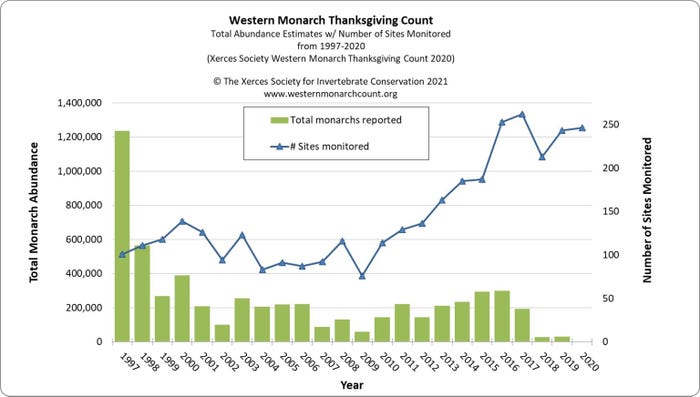Warm and dry summer followed by the traditional cooler temperatures of the fall could have contributed to the monarch population increase.
December 29, 2021

The official 2021 western monarch tally will not be known until early 2022 but early observations indicate a promising rebound for these monarch populations.
"Nature has given us a second chance," Emma Pelton, a biologist with the Xerces Society, told NPR last month.
Farmers for Monarchs detailed earlier this year the alarmingly low 2020 western monarch butterfly count. In 2020, the annual Western Monarch Thanksgiving Count surveyed 246 sites last year with only 1,914 total monarchs counted. The 2020 survey was a stark drop even compared to the previous all-time low counts in 2018 and 2019, when only around 30,000 monarchs were counted each of those years.

The overwintering numbers in the West in 2021, however, are a dramatic improvement from recent lows.
"We already see numbers way better than the last couple of years," Pelton remarked to NPR.
The Western Monarch Count, the volunteer initiative led by Xerces Society to count overwintering butterflies along the coast of California around Thanksgiving and New Year's Day, issued a news update in October about the increased number of monarchs already being spotted in California this year.
"On October 16th, 2021, over 1,300 monarchs were counted at the Pacific Grove overwintering site; this site did not have a single monarch butterfly during last year's count. Pismo State Beach Monarch Butterfly Grove and an adjacent site tallied roughly 8,000 monarchs on October 20th, 2021; last year, these sites hosted less than 300 butterflies," Western Monarch Count noted in the news update.
"Additional smaller estimates and observations from volunteers and the public have started to pour in from the Bay Area, Santa Cruz, Monterey, Big Sur, Ventura, Los Angeles and elsewhere, with numbers ranging from a few to dozens to hundreds, of monarchs. Altogether, there appear to be over 200,000 monarchs easily accounted for at the overwintering sites," continued the update.
Optimism has only increased since these initial sightings as Pelton noted in a November blog post titled, "The Bounciness of Butterflies," that monarch counts grew to more than 10,000 monarchs at each of the locations mentioned above with more sites yet to be visited.
Pelton also speculated plausible reasons as to why monarch populations have bounced back this year, although with the caveat that it is too early to make any definitive conclusions. She mentioned factors like less competition for resources, a boost in capacity to increase size, and even changes to the timing of the wildfire season in the West. Pelton also highlighted how the combination of good weather and good luck across the breeding grounds could also be factored into the rebound. The warm and dry summer followed by the traditional cooler temperatures of the fall could have contributed to the monarch population increase.
Despite the positive early indications of a strengthening monarch population, the final tally will not be known until early 2022. Whatever the reasons for the increased number of monarchs, it will take some more time after that to assess as to why the increase occurred. And while an increased number of western monarchs should be celebrated, it also serves as an indication that monarch and pollinator conservation efforts are working and those efforts should be increased.
You May Also Like


.png?width=300&auto=webp&quality=80&disable=upscale)
